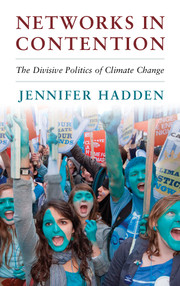Book contents
- Frontmatter
- Dedication
- Contents
- List of Figures
- List of Tables
- Acknowledgments
- Introduction
- 1 The Copenhagen Moment
- 2 The Emergence of a Divided Civil Society Network
- 3 A Network Approach to Collective Action
- 4 Conventional Climate Advocacy
- 5 Climate Justice Activism
- 6 Implications for Climate Change Politics
- Conclusion
- Main Abbreviations Used
- Methods Appendix
- References
- Index
- Books in the Series
4 - Conventional Climate Advocacy
Published online by Cambridge University Press: 05 April 2015
- Frontmatter
- Dedication
- Contents
- List of Figures
- List of Tables
- Acknowledgments
- Introduction
- 1 The Copenhagen Moment
- 2 The Emergence of a Divided Civil Society Network
- 3 A Network Approach to Collective Action
- 4 Conventional Climate Advocacy
- 5 Climate Justice Activism
- 6 Implications for Climate Change Politics
- Conclusion
- Main Abbreviations Used
- Methods Appendix
- References
- Index
- Books in the Series
Summary
This chapter deals with the portion of the interorganizational network engaged in conventional climate change advocacy. Individuals working in this sphere were tireless in Copenhagen period. One described the experience of COP 14 in 2008 as follows:
I've been up since 7 a.m., every day, because I've had to meet with the coordination group in the morning. I do media; I meet with my working group. Then I have to go to the CAN coordination meetings – two of them every day of course. I'm, of course, really here to meet with delegates and discuss our issues. Sometimes it's hard to remember that. Getting intelligence, feeding it back to the working groups, writing statements, sending them to the media. I barely eat – I don't have the time. Last night I was up until 2 a.m. because I was working on an article for [the NGO newspaper]. It's completely exhausting. But I just keep asking myself, if we didn't do it, who would? You know that the business groups are working twice as hard, so we have to be here too.
(Interview, Climate Action Network 2008)The activities described – lobbying, working with the media, and writing articles – are all well-established routines within the Climate Action Network (CAN). CAN is one of the biggest and most professional transnational advocacy networks in the world and was well established by the start of this study. Despite our interest in transnational advocacy networks, we often know little about the ways in which they form and the internal struggles and compromises that keep them together (but see Bülow 2010). The first part of this chapter examines CAN's internal politics to explain how organizations came to form this coalition, and why it took on the structure and character that it did.
The second part of the chapter explains how embeddedness in the CAN coalition influenced the tactical and framing choices of its member organizations.
- Type
- Chapter
- Information
- Networks in ContentionThe Divisive Politics of Climate Change, pp. 89 - 113Publisher: Cambridge University PressPrint publication year: 2015



